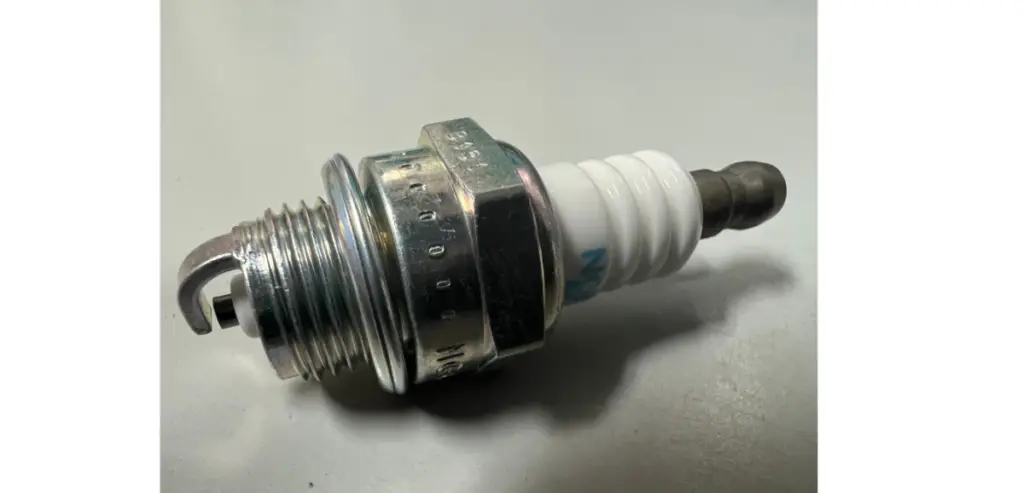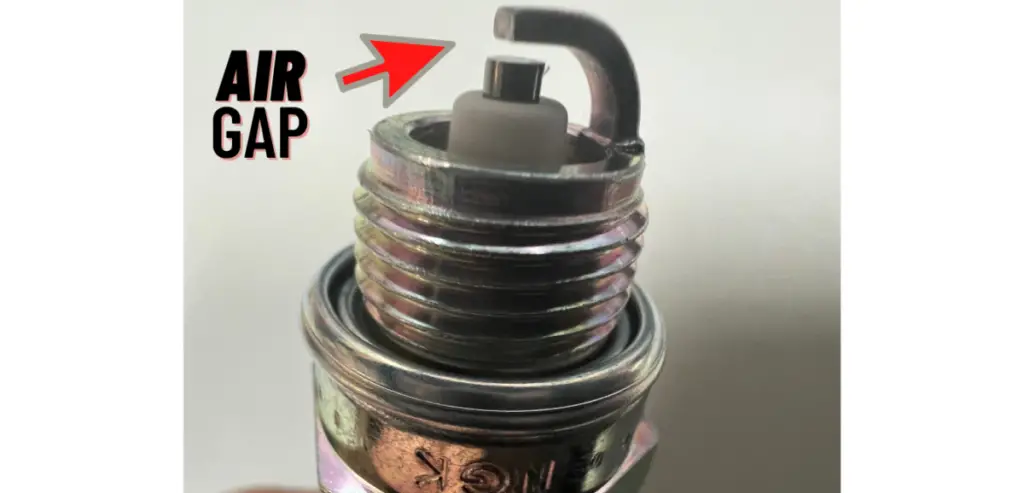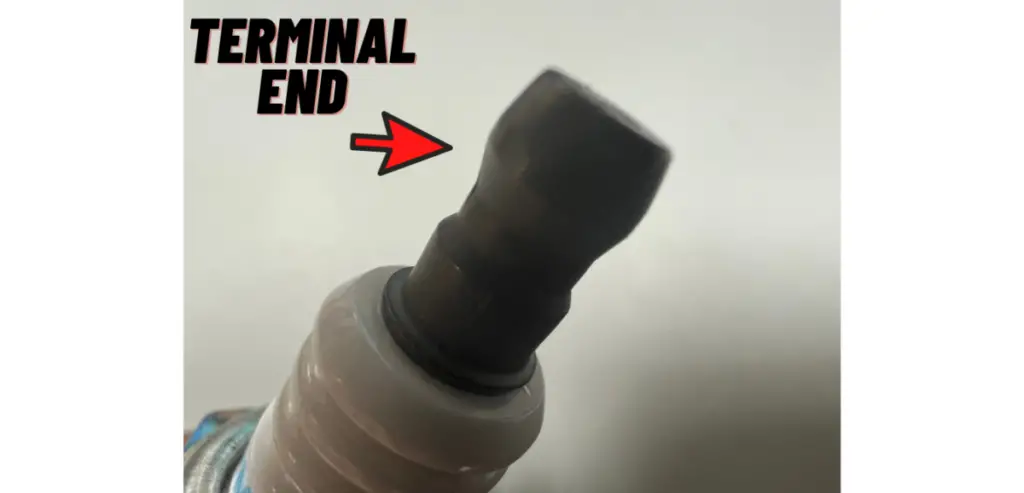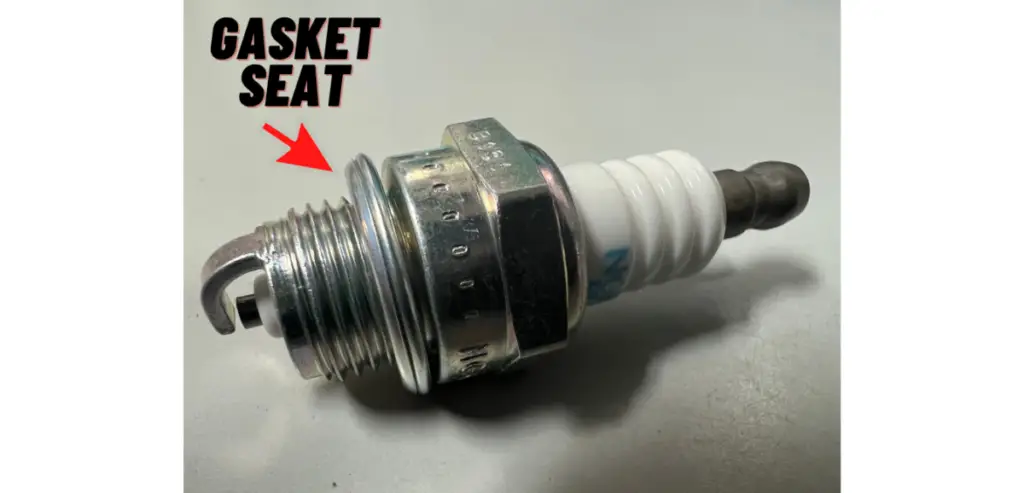
A spark plug is a key component of a chainsaw that needs to be replaced at least every 100 hours of chainsaw operation or earlier.
When replacing a chainsaw spark plug can you use any spark plug?
Are all chainsaw spark plugs the same?
Chainsaw spark plugs can have differences with the following.
- Spark Plug Gap
- Spark Plug Heat Range
- Spark Plug Removable or Non-Removabel Terminal Cap
- Spark Plug Resistence Module
- Spark Plug Gasket Seat vs Tapered Seat
Spark Plug Air Gap

The spark plug gap is the space between the spark plug’s central electrode and the ground or side electrode.
This spark plug gap is set to a specific distance called for in the specifications of a chainsaw.
If the gap is too large the voltage of the chainsaw’s ignition coil will not be able to jump the gap and ionize properly and the spark will be weak. Weak spark leads to misfires, carbon build-up, and a poorly running engine.
On the other hand, if the spark plug gap is too small the voltage of the ignition coil will not be able to ionize (spark) properly if at all. If the voltage is able to make the jump across the small gap the engine may experience misfires, hesitation, and rough running in general.
All of this can be avoided by selecting a spark plug that is pre-gapped to your chainsaw’s specifications. You can also set your spark plug gap with a feeler gauge.
Most chainsaw spark plug gaps range from .02″ (0.5mm) to .03″ (0.8mm).
Spark Plug Heat Range

The heat range of a spark plug refers to how quickly the spark plug transfers heat to the engine head from the combustion chamber of the chainsaw.
The combustion chamber of any gasoline engine needs to be in a range that avoids overheating while at the same time being hot enough to burn away engine residue and carbon. The optimal heat range of a combustion chamber on a gasoline engine is 500 celsius / 932 Fahrenheit to 850 celsius / 1562 Fahrenheit.
Chainsaw spark plugs may be visually identical but have differing heat ranges. The wrong heat range plug can damage your chainsaw.
Always be sure you select a spark plug with the correct heat range for your chainsaw.
Spark Plug Removable or Non-Removable Terminal Cap

The tip of a spark plug is known as the terminal. Some spark plugs have removable terminals while other spark plugs have non-removable terminals.
Removable terminal spark plugs are good for engines that do not have a high level of vibration. On the flip side non-removable spark plug terminals work best for engines that do have a high degree of vibration, because they do not loosen. A loose terminal cap can cause an insecure electrical connection and cause an engine to malfunction.
Chainsaws engines have significant vibration while running and are better suited to non-removable terminals. A non-removable terminal cap provides a more stable connection between the spark plug and ignition module.
Spark Plug Resistence Module

The resistance module of a spark plug is a component of the spark plug that intercepts the electrical current flow and softens its electromagnetic static field.
Chainsaws have ignition module electrical systems that can be affected by the electromagnetic static field produced by a non-resistor spark plug. The electromagnetic interference can cause a chainsaw’s ignition module to malfunction and possibly fail completely.
If your chainsaw’s owner’s manual calls for a resistor spark plug, it is best to use one. Using a non-resistor spark plug in a chainsaw that requires a resistor spark plug can damage your chainsaw.
Spark Plug Gasket Seat vs Tapered Seat

The spark plug seat is the bottom of the spark plug that seals to the chainsaw engine’s combustion chamber.
Spark plug seats come either as a gasket seat or a tapered seat.
Gasket Seat Spark Plug
A spark plug with a gasket seat creates a seal with a gasket that is crushed when the spark plug is tightened into the engine. The gasket seat is by far the most common type of spark plug seat used in chainsaws.
Tapered Seat Spark Plug
The tapered seat spark plug does not use a gasket at all, but rather a taper on the spark plug’s outer shell to create a seal with the combustion chamber. The tapered seat spark plug is rarely used in the chainsaws of today.
The specifications of a chainsaw will dictate whether a gasket seat or tapered seat spark plug should be used.
Using the wrong type of spark plug seat can damage your chainsaw.
What Kind of Spark Plug Does A Chainsaw Take?
Popular brand chainsaws like Stihl and Husquvarna more commonly take resistor-style spark plugs like the NGK BPMR7A. However, some chainsaws require spark plugs with different specifications like specific heat ranges, spark plug gaps, and terminal end types.
Be sure to check with your chainsaw’s owner’s manual to get the appropriate spark plug for your chainsaw’s model.
NOTE: The wrong spark plug can possibly damage your chainsaw’s engine or ignition module coil.
What Size Spark Plug Does A Chainsaw Take?
The spark plug of a chainsaw can come in different sizes in relation to the size of the wrench needed for removal.
Chainsaw spark plugs primarily come in 3/4 (19mm), 5/8 (16mm), or 13/16 (21mm) hex head sizes.
A spark plug wrench or a ratchet with a deep socket of the appropriate size is recommended to easily remove the spark plug of a chainsaw.
Wrapping Up
When seeking a replacement spark plug, it is always best to refer to your chainsaws owner manual or reputable information source. This will ensure you purchase the correct spark plug or equivalent for your chainsaw.
Remember, just because spark plugs may visually look the same does not mean that they are the same.
Different models of spark plugs can have differences in regards to spark plug air gap, heat range, terminal caps, resistance models, and spark plug seats.
Be sure that you are replacing your spark plug with one that meets the chainsaw manufacturer guidelines.
The wrong spark plug can actually damage your chainsaw’s piston and ignition coil module.
Good luck with your spark plug replacement and be safe out there!

